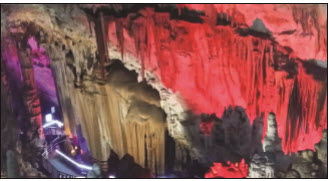Be Truly Open-Minded
Happy New Year! Fellow HGS members- From Bulletin Editor Fang Lin....
I hope you all have had a great holiday season and are fully recharged for 2020.
At the end of November, I went on vacation in China. First, I want to thank the HGS Editor-Elect Ceri Davies, Design Editor Lisa Krueger, the HGS Office Director Andrea Peoples and former HGS Web Content Manager Jacky Jordan for their help while I was away. Without them, the December issue of the HGS Bulletin could not be published without delay.
For the two weeks in China, I spent one week in Beijing and had the opportunity to visit many “new” architectural masterpieces that were constructed in recent years, such as the “Bird’s Nest” and “Water Cube”, which are the primary competition venues during the 2008 Beijing Olympics Games. I also visited places more representative of the traditional culture, such as the Nanluogu Ally, which is a pedestrian-only street, built in ancient China style, with all kinds of traditional snacks and refreshments sold along the street. If you like food just like me, a place highly recommended. However, among all the places that I visited during that week, one place that really surprised me and impressed me is a geologic park called Shihuadong, translating into Rock Flower Cave, in suburban Beijing. 
It was a cold windy day, not ideal for outdoor activities in winter Beijing. We kind of exhausted ideas of where to go on that day. So, my relatives asked if I had been to the Rock Flower Cave. They thought I might be interested since I am a geologist. In addition, because it’s a cave, we won’t be exposed in the freezing air. Frankly speaking, my first thought after hearing the proposal was – uh…I am a geologist who have been to quite some places. “Rock Flower Cave”, with no disrespect, the name of the place sounds a little rustic. Moreover, for the half dozens of times that I visited Beijing, I never heard of it, not even from my geology friends. So, it must be some tiny mediocre cave that impresses the non-geologists, but not me. The other thing that led me to that conclusion apparently came from my geologic knowledge, proven to be limited later, about China. Through my years of academic study, I know that world-class Karst topography in China mainly exists in southern provinces, pictures of which we often see on post-cards and covers of magazines. Here in the great flat plains of northeastern China, the right place to study Banded Ion Formation or Proterozoic rocks if you are willing to drive to the mountainous areas at the edges of the plain. Karst? Unheard of.
Nevertheless, my relatives seemed insisting and really wanted me to go, and we really couldn’t think of any other places that we haven’t been and would like to visit on that day. Then let’s go!
Rock Flower Cave (“Shihuadong Scenic Area” as shown in Google Map) is about 50 kilometers (~31 miles) west of the center of Beijing City. Depending on the traffic, it may take 1-1.5 hours to get there by car during the daytime. As we approached the site, everything looked typical rural area in China, with some mild mountains (i.e., comparing with the lofty ones in western China near the Tibetan Plateau) in the surroundings. After paid for the entrance fee (~10 USD/person), we were ushered into the cave by a tour guide. Then I realized this is not a small cave at all! In front of me are magnificent underground halls that are at least 20-30 meters tall. As we moved forward with the tour guide, we learned that there are seven levels of caves in the mountain, each has their characteristic chemical deposits. At present, only level one, two, three and four are open to the public, with a total walkable path of 2.5 kilometers. The caves were formed 4.5 – 5 million years ago (Ordovician age). Total height of the cave system is more than 150 meters. One can find all kinds of speleothems in the caves, stalactites, stalagmites, cave curtains, columns, gypsum flowers, etc. The colorful lights installed by the site management to shine on the walls of the caves made them even more reverie. I had not been in a cave like this for a long time. It was wonderful to walk around it and even be able to touch part of it! The cave has a near isothermal atmosphere year-round, 11°C – 13°C. So, it was a lot warmer than the outside and was shielded from the wind! I am very glad that I did not let my first thought to dismiss the opportunity to visit this place. It was certainly worth visiting.
My lessons learned through this experience? Be truly open-minded. Sometimes we get trapped into our presupposed ideas and expert opinions and forgot other possibilities out there. However, what we, the humans, have learned about this 4.6 billion-year old planet is a tiny little fraction of its history. I think the President’s Letter on The Cactolith Discovered in the December issue of the HGS Bulletin is telling us the same thing. Be truly open-minded is particularly important for exploration geologists. We must remain truly open-minded to discover the unknow, to advance science and technology, and to grow ourselves.
Have a great start of 2020. Until next month.
